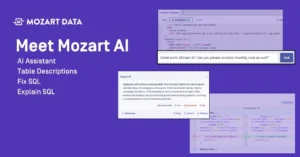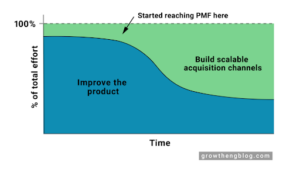A data lake can be used to provide organizations of any size with efficient, reliable, and flexible storage, allowing them to quickly extract and transform raw data and make informed decisions about any aspect of their operations. This article will explain what a data lake is and how tools like AWS provide businesses with scalable options to meet their needs.

What is a data lake?
A data lake is a central location in which all of your raw data can be stored. For example, if you run a shipping company, your lake could ingest data on customer queries, shipping rates, promotions offered by your partners, and much more.
Both structured and unstructured data can be kept in your data lake and the scale of the repository can be adjusted to meet your needs. Most of the time, scaling takes place automatically, so if the volume of data increases suddenly due to an unforeseen event, you won’t lose any valuable data.
All big data repositories that are categorized as data lakes satisfy the following criteria:
-
They are a single, shared repository
-
They include job scheduling and orchestration capabilities
-
They contain workflows to process the data
Data lakes don’t suffer from the level of replication of data that’s often observed with data silos. They use a flat, not hierarchical, structure and data is often stored in objects. This way, they aren’t only relying on the files or folders that are used in data warehouses.
Since object storage uses metadata tags and unique identifiers, it’s easy to locate data across different regions, even if you’re operating a global company. This benefit of object storage makes data lakes more adaptable to modern use cases
Data lakes were developed to address the limitations of data warehouses, such as cost and their inability to handle the use cases that arise nowadays. For example, most companies maintain accounts on several social media platforms and have unique campaigns to meet the particular needs of customers on each platform.
They engage with these customers in real time, every day. They’re constantly collecting data on the types of questions that customers ask about their products and data lakes let them quickly store all of that data.
Lakes don’t require any type of schema or formal structure for how the data will be organized and all data can be stored as it is. When analysis needs to be done, the data will still be available in its raw format, so it will be almost like analyzing it in real time.
Data Marts vs Data Lakes
A data mart is often thought of as a subgroup of a data warehouse. It contains data that’s already been packaged to meet a particular need.
Data marts suffer from many of the same constraints of larger data warehouse, but also only allow the user to look at a small subset of data, which has already been filtered.
A data lake contains data in its raw state. Data flows straight in from a variety of channels and no data is turned over to another storage location.
Data lakes receive information in its native format. This means that a larger and more timely flow of data is available for analysis.
In this type of structure, data streams can be processed in real time. Data can also be ingested in batches. Data can be written into partitions by using the most optimal format and it can even be reentered when necessary.
This type of structure doesn’t have fixed capacity limits and that makes it easy to scale. Data can be transformed into formats like Parquet which have high compression ratios.
Advantages Of Using Data Lakes
Data lakes help analysts to manage the large volume of data that most businesses receive. Data is kept in its natural state, so analysts can examine it freely.
You can store all types of data in a data lake. For example, all of your CRM data can be kept there and your social media posts can be saved there each day. All of your big data, from all across the cloud, can be kept in one place.
In addition to having your online data in one place, data from your physical environments is also available in the same location for analysis. You can assess performance across your entire enterprise instead of looking at a skewed report.
You can save money by using data lakes to meet your storage needs. Most are designed to run on affordable commodity hardware and may often use open-source software that results in additional savings. The open-source nature of data lakes leads to more options, with respect to the type of software that can be used with them.
Data lakes completely eliminate the need for data silos, while offering you a more comprehensive look at what is happening across your entire organization. You won’t have to keep going back and forth among silos to get the clear picture you need.
With most data lakes tools, your data is always encrypted for security. You can also apply a wide selection of tools which are designed to help you understand what your data means.
Types Of Data Lake Architecture
All types of data lake architecture are meant to decrease costs while facilitating multiple workloads. The architecture should allow users to easily access the data that they require, so the following features should be incorporated to ensure that the lake functions well:
-
Data profiling tools
-
Taxonomy of data classification
-
File hierarchy
-
Tracking mechanisms
-
Data security
Secure data lakes receive data from a variety of sources, including data warehouses and applications, and the data is encrypted for your protection. The data is stored in an open format, making it independent of any platform.
Data lake tools like Azure are used to store data of any shape or size. Many data lakes are built by using Hadoop and tools in the Hadoop because they make it easy to extract specific data in response to your queries.
The Most Popular Data Lake Tools
Snowflake
Snowflake offers a cloud-built architecture that combines multiple data tools into one easy-to-use data cloud. That includes a data lake and data warehouse, although it also comes with data governance and security tools already built in.
Snowflake makes all of the data pertaining to your business available to a virtually unlimited number of users. Analysts on your marketing team will have access to the same amount of data as those in customer support.
Each analyst can perform queries to meet their needs. Their results won’t be biased due to limited access to data and every stakeholder who you give permission to can have a sense of what’s happening across the organization.
Snowflake is designed to reliably scale your data pipelines in real time. As data is being sent to your data lake on busy days, they’ll adjust to match the workload, meeting your unique needs.
Snowflake’s ability to accommodate an almost unlimited number of users is matched by the number of queries that it can handle. It can process as many concurrent queries as your company needs.
You can auto ingest your data and efficiently transform it. You can even adjust the ingestion style of each pipeline to suit your needs.
Azure
Like other data lake tools, Azure lets businesses store data of any speed or size. It’s built on YARN, so it’s suitable for cloud applications. Like other data lake tools on this list, Azure offers business in any sector a high level of flexibility and agility.
Azure is preferred by companies that have demanding workloads. You can conduct large scale queries without having to compromise on performance.
Azure can be used to store and analyze trillions of objects. It’s highly scalable, so your business can obtain as much processing power as you require. You can adjust your storage costs to match your budget, since it varies according to how much you actually use.
Companies can effortlessly debug their big data programs, while enjoying enterprise-grade security. You can use Spark and other linked analytic engines with Azure, run real-time analytics and build reports that lead to better decisions and actions.
AWS
Data lakes on AWS are flexible and can import any quantity of data in real time. You can collect data from several sources that are related to your business and use the associated suite of analytics services to make quick business decisions.
AWS makes automatic lake formation easy, so that data lakes can be built and secured in days, instead of months. You can move a part of your data from one data store to the next and combine or replicate it across your data lake.
Capabilities like column-level data filtering and centralized access control let you manage access to your purpose-built stores from one place. AWS scale data lakes helps you to get insights that aren’t possible with several siloed databases.
How Mozart integrates with your data lake
Remember when we mentioned above how nice it is that Snowflake has a data lake and data warehouse all in one place? It just makes things easier.
That’s what we built Mozart to do: to put your whole data stack in one place, in the cloud, so that everyone on your team can use it. Your whole team should be able to access and interpret your data to discover new insights, not just the data engineers (they’re still plenty important, but they have better things to do than pulling endless reports for the growth team.)
When you hook Mozart up to your data lake, you’ll be able to rapidly transfer and clean your data to make it more useful to your team. After that, it’s just a couple of clicks – and a little bit of basic SQL – to connect it to the rest of your data stack. Your data will be clean, organized, and ready for the business intelligence team in no time.
A data lake will store all of your company’s data efficiently and help you keep your costs down, since your data is only processed when it needs to be used. You can store all types of data at a low cost, while providing access to numerous stakeholders, but not until your analysts need it.


